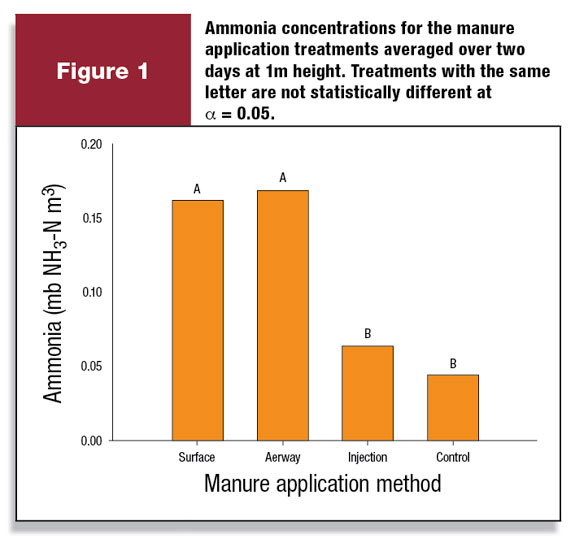Dairy farmers can greatly reduce ammonia emissions from their production facilities by injecting liquid manure into crop fields below the soil surface, according to research conducted by the U.S. Department of Agriculture (USDA). By reducing ammonia emissions, valuable nitrogen can be conserved which will be available for crop growth, thereby reducing the need for inorganic fertilizers.
In addition, in many states, air quality regulations require the implementation of best-management practices to reduce ammonia emissions, as these emissions are precursors to the formation of PM2.5 (particles with diameter <2.5μm) particulate matter, which is a human health concern.
These findings, which resulted from a study conducted by soil scientist April Leytem and agricultural engineer David Bjorneberg with USDA’s Agricultural Research Service (ARS), could help dairy farmers increase nitrogen capture in the soil and protect air quality from agricultural ammonia emissions. ARS is USDA’s principal intramural scientific research agency.
The scientists work at the ARS Northwest Irrigation and Soils Research Laboratory in Kimberly, Idaho, and conducted their study on four dairy farms in southern Idaho, a state where the number of milk cows has increased 88 percent in the last decade.
They applied liquid dairy manure (at a rate of 20,000 gallons per acre) stored in containment ponds either by surface broadcasting, using a rolling tine aerator to incorporate manure into the top four inches of the soil surface, or injecting the manure 12 inches below the soil surface.
These application rates applied between 18 to 119 lbs of nitrogen per acre, with the application rates on treatment plots at each farm being the same. Immediately after application of manure, field plots were monitored using passive ammonia traps to determine the concentration of ammonia at 3’, 6’, and 12’ above the soil surface.
An area upwind of the dairy was used to determine background ammonia concentrations at each location. The ammonia traps were changed daily over a three-day period following manure application to determine the change in ammonia concentrations over time.
Using passive samplers to measure ammonia concentrations is a valuable low-cost tool for determining relative differences in potential ammonia losses between application methods.
Most models used to calculate ammonia fluxes and/or mass losses utilize concentrations data in combination with micrometeorological data for the calculations. As the micrometeorological data were the same for each treatment on each farm, the difference in flux/mass losses would be strictly due to differences in ammonia concentrations.
Over the three-day study period, the greatest losses of ammonia were recorded during the 48 hours immediately following the manure applications, with the majority of losses occurring within 24 hours.

Surface broadcasting manure resulted in an average ammonia concentration of 0.17 milligrams of nitrogen per cubic meter, and shallow incorporation resulted in an average ammonia concentration of 0.16 milligrams of nitrogen per cubic meter.
Fields where manure had been applied using subsurface injection had an average ammonia concentration of 0.06 milligrams of nitrogen per cubic meter, which was 65 percent lower than losses resulting from manure application via shallow incorporation or surface broadcasting.
There was no significant difference in the concentration of ammonia from subsurface injection of manure or the background sites, suggesting that ammonia losses were negligible when manure was injected.
These results suggest that immediate incorporation of manure is needed to minimize ammonia losses, and the benefits are greater when manure is incorporated within 24 hours and lesser when incorporated within 48 hours.
It should be noted that the manure application using the rolling tine aerator to incorporate the manure could potentially reduce ammonia emissions if lower application rates were utilized or if the system was used in pasture as opposed to cropland and was utilized in the present study.
Leytem and Bjorneberg concluded that dairy farmers who land-apply manure could best reduce ammonia emissions by using subsurface injection, and that immediately incorporating manure deep into the soils during its application can limit losses of manure nitrogen from ammonia volatilization. PD

-
April Letem
- Soil Scientist
- USDA - ARS
- Email April Leytem





